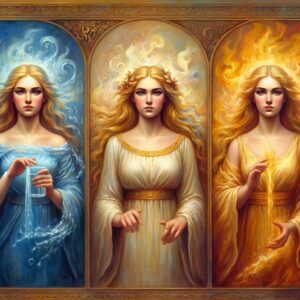The Foundation of Creation: Numbers, Letters, and Sounds
The Sepher Yetzirah posits that the universe was created by Yah, the Jehovah of hosts, the God of Israel, the Living Elohim through thirty-two mysterious Paths of Wisdom engraved by the three Sepharim—Numbers, Letters, and Sounds. This highlights the fundamental role of numerology and the Hebrew alphabet in the Kabbalistic understanding of creation. Each letter is not merely a symbol but also carries a numerical value and a deeper significance. The interconnectedness of numbers and letters is emphasized, “every letter suggesting a number, and every group of letters having a numerical signification, as vital as its literal meaning” (Introduction, paragraph 3).
The Ten Ineffable Sephiroth and Twenty-Two Letters
The text introduces Ten ineffable Sephiroth and Twenty-two Letters, the Foundation of all things. These are the primary building blocks of the cosmos. The twenty-two letters are further categorized into Three Mothers, Seven Double and Twelve Simple letters. Each category plays a distinct role in the formation of reality. The Sephiroth are described as having “ten vast regions bound unto them; boundless in origin and having no ending” (Yetzirah 1:5). They are likened to a lightning flash with a cyclical nature, “the Word is in them as they rush forth and as they return” (Yetzirah 1:6). The number ten is presented as a fundamental and complete unit.
The Role of the Three Mother Letters
 (Aleph, Mem, Shin)
(Aleph, Mem, Shin)
These three letters are identified as Air, Water and Fire and are considered the foundation of all the other sounds and letters. They are depicted as a balance, with Air (Aleph) acting as the “tongue of a balance standing between these contraries which are in equilibrium, reconciling and mediating between” Water and Fire (Yetzirah 2:1c). These Mother letters are also correlated with the three realms of existence: the heavens (Fire), the earth (Water), and the air (Spirit). They are further reflected in the Year (heat, cold, temperate) and in Man (head, belly, chest).
The Significance of the Seven Double Letters
(Beth, Gimel, Daleth, Kaph, Peh, Resh, Tau)
Each of these letters has “two sounds associated with them; they are referred to Life, Peace, Wisdom, Riches, Grace, Fertility and Power” (Yetzirah 4:1a). These letters are linked to seven localities; Above, Below, East, West, North, South, and the Palace of Holiness in the midst of them sustaining all things, as well as the planets of this world, the days of the week, and the gates of the soul in mankind (Yetzirah 4:3a). The text states that “From these Seven He hath produced the Seven Heavens, the Seven Earths, the Seven Sabbaths,” highlighting the pervasive influence of the number seven in creation (Yetzirah 4:3b).
The Twelve Simple Letters
(Héh, Vau, Zain, Cheth, Teth, Yod, Lamed, Nun, Samech, Oin, Tzaddi, Qoph)
These letters are described as “the foundations of these twelve properties: Sight, Hearing, Smell, Speech, Taste, Sexual Love, Work, Movement, Anger, Mirth, Imagination, and Sleep” (Yetzirah 5:1b). They are also allotted to the directions in space and correlated with the twelve celestial constellations of the Zodiac, the months of the year,” and the twelve organs of living creatures.
God’s Unity and Immanence
The Sepher Yetzirah emphasizes the supreme doctrine of the Unity of God, contrasting it with dualistic and polytheistic beliefs. Rabbi Moses Botarel’s commentary is quoted stating that Abraham wrote the book to condemn those who doubted this unity. Adolphe Franck’s analysis highlights that the “last word of this system is the substitution of the absolute divine Unity for every idea of Dualism” (Introduction, paragraph 15). God is presented not as separate from creation but as intimately connected, “God considered as the Infinite and consequently the indefinable Being, extended throughout all things by his power and existence, is while above, yet not outside of numbers, sounds and letter” (Introduction, paragraph 16). The concept of the “Word (Logos), the Holy Spirit” as the common origin of all things suggests a divine emanation inherent in creation (Introduction, paragraph 17).
Historical Context and Authorship
The introduction discusses the historical debate surrounding the authorship and dating of the Sepher Yetzirah. While tradition ascribes it to Abraham or Rabbi Akiba, modern scholars suggest later dates, possibly during early Gnostic times or the Geonim period. The text acknowledges the existence of commentaries by various historical figures and the availability of different Hebrew and Latin editions. The relationship between the Sepher Yetzirah and the Zohar is noted, with the former focusing more on “our universe and with the Microcosm” (Introduction, paragraph 6), while the latter concerns “the essential dignities of the Godhead” and the Sephiroth (Introduction, paragraph 5).
The Thirty-Two Paths of Wisdom
The latter part of the excerpt introduces “The Thirty-Two Paths of Wisdom,” which are directly linked to the thirty-two mysterious paths mentioned in the first verse. These paths are presented as levels or aspects of divine intelligence and understanding. Each path is given a descriptive name, such as “the Admirable or the Hidden Intelligence,” “the Illuminating Intelligence,” and “the Sanctifying Intelligence” (Thirty-Two Paths of Wisdom 1:1-3). The descriptions of these paths delve into abstract Kabbalistic concepts related to emanation, creation, and the nature of divine influence. For example, the Fourth Path “contains all the holy powers, and from it emanate all the spiritual virtues with the most exalted essences ” (Thirty-Two Paths of Wisdom 1:4).
Quotes
In thirty-two mysterious Paths of Wisdom did Yah, the Jehovah of hosts, the God of Israel, the Living Elohim… engrave his name by the three Sepharim—Numbers, Letters, and Sounds.” –Yetzirah
Ten are the ineffable Sephiroth: Twenty-two are the Letters, the Foundation of all things; there are Three Mothers, Seven Double and Twelve Simple letters.” –Yetzirah
every letter suggesting a number, and every group of letters having a numerical signification, as vital as its literal meaning.” –Yetzirah
The Three Mothers are Aleph, Mem and Shin, they are Air, Water and Fire.” –Yetzirah
Water is silent, Fire is sibilant, and Air derived from the Spirit is as the tongue of a balance standing between these contraries which are in equilibrium, reconciling and mediating between them.” –Yetzirah
These Seven Double Letters point out seven localities; Above, Below, East, West, North, South, and the Palace of Holiness in the midst of them sustaining all things.” –Yetzirah 4
The Twelve Simple Letters… are the foundations of these twelve properties: Sight, Hearing, Smell, Speech, Taste, Sexual Love, Work, Movement, Anger, Mirth, Imagination, and Sleep.” –Yetzirah 5:1a
The First Path is called the Admirable or the Hidden Intelligence (the Highest Crown): for it is the Light giving the power of comprehension of that First Principle which has no beginning…” –Thirty-Two Paths of Wisdom 1:1
Conclusion
The excerpts from the Sepher Yetzirah provide a glimpse into a complex and ancient system of cosmology rooted in the Hebrew alphabet and numerology. The text outlines a hierarchical structure of creation emanating from the divine through the Ten Sephiroth and the Twenty-Two Letters. It emphasizes the unity of God and His immanence within creation. The introduction offers valuable historical context and situates the Sepher Yetzirah within the broader Kabbalistic tradition. Finally, the description of the Thirty-Two Paths of Wisdom hints at a profound system of divine intelligence that underpins the fabric of reality. This treatise is not a literal creation story but rather a philosophical exploration of the fundamental principles governing the universe.


